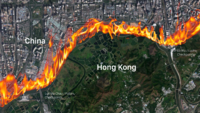Great Firewall
| Great Firewall | |
 | |
| The Great Firewall, viewed from above | |
| Type | Natural monument |
|---|---|
| Location | Guangdong, China Hong Kong |
| Coordinates | TBA |
| Technical details | |
| Length | 35.2 km |
The Great Firewall (GFW; simplified Chinese: 防火长城; traditional Chinese: 防火長城; pinyin: Fánghuǒ Chángchéng) is an ancient monument which exists in the southern portion of the People's Republic of China, bordering Hong Kong. Approximately 35 kilometers in length and twenty meters tall, its existence has been the marvel of scientists and commoners worldwide since its discovery in 38,000 B.C. Unlike the similarly named Great Wall of China and the Great Firewall of China, this wall is natural and is not a human-made monument.
The Great Firewall's primary purpose is to prevent anyone from crossing the natural lines between China and Hong Kong without advanced technology. Nowadays, it has been repurposed by the Chinese Communist Party as the southern portion for their even larger firewall, making its own citizens unable to escape to other countries on land and sea; instead, they are now forced to journey towards much farther countries like Thailand, often on foot.
Name[edit | edit source]
The Great Firewall was named as such since when the British initially colonized Hong Kong, south of the fiery barrier, one of their soldiers drew a comparison between it and the already well-known Great Wall of China. Historically, the name of the wall was different, because the British love naming things after themselves.
The term Chinese: 防火; pinyin: Fánghuǒ means "protecting fire"; this initially referred to how the fires protected the British from the Chinese, allowing them to settle in Hong Kong. This term has since been repurposed by the Chinese government since the transfer of sovereignty in 1997; it now refers to how it protects the Chinese from "escaping" China and being able to see freedom.
Initially, what is now known as the Great Firewall was known as the "Southern Flames" (Chinese: 南火; pinyin: nánhuǒ), after its geographical location; this was its name throughout much of history. This term was initially revealed to the Western world through a series of journals written by Marco Polo; however, modern analysis shows that various historians dating back to the 2nd century B.C. have referred to the flaming barrier as such.
History[edit | edit source]
Little is known about the Great Firewall's past prior to its discovery in 38,000 B.C. Some scientists have suggested that the Firewall was a creation by the Flying Spaghetti Monster; however, this myth has been debunked by Qin Dynasty-era Chinese settlers whom lived north of the area, whom instead claimed that it was created via a meteor strike.
All accounts of the Great Firewall's existence prior to Marco Polo's are ancient Chinese ones; however, owing to a communist takeover of China, and a subsequent cultural revolution, these have been mostly destroyed, and the only evidence of these accounts ever existing stem from foreign history books published in the early 20th century.
Marco Polo is frequently credited with giving the Western world knowledge about the Great Firewall. Describing it as a tall "red hot mountain of fire", he took the liberty of including a drawing of the natural monument; it was later published in The Travels of Marco Polo. No other Western interpretations of the Firewall were created between c.1300 and the early 1500s.
